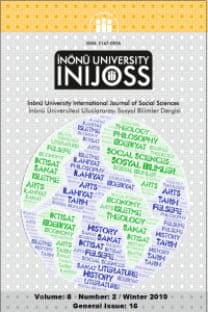ALMAN MİLLİYETÇİLİĞİNİN TARİHSEL KÖKENLERİ
Öz
Alman Milliyetçiliğinin tarihsel kökenleri meselesi bir
makalenin konusu olmaktan ziyade uzun uzadıya tartışılması gereken bir
konudur. Milliyetçilik, ortaya çıktığı XIX. yüzyılın ikinci yarısı
itibariyle “ulus” kimliğine dayanan modern devletler kurma veya böyle bir
devleti olduğu gibi sürdürme amacı güden siyasî bir doktrin idi. Her ne kadar
XIX. yüzyılın sonlarında ortaya çıkmış bir kavram dahi olsa Almanlar açısından
durum farklıydı. Milliyetçilik ideolojisi ortaya çıkmadan çok daha önce
Almanlarda ulus bilinç kazanma yolunda önemli gelişmeler kaydedilmişti.
Almanlar bunu ulusal bütünlüklerini oluşturma yönünde yeni bir adım olarak
gördüklerinden, ulusal bilinci oluşturma yönünde bir takım girişimlerde
bulunmuşlardır. Makalemizde bu girişimlerin tarihsel süreci ortaya konulmuştur.
Bu süreç ortaya konulurken iki temel mit üzerinden hareket ettik. Bunlardan
ilki “ortak ata miti” ve diğeri “ortak dil miti” . Bu iki temel mit üzerinden
Almanlardaki milliyetçi eğilimleri incelemeye çalıştık.
Anahtar Kelimeler:
: Cermen, Milliyetçilik, Ortak Dil, Ortak Ata
___
Becanus, G. Johannes (Jan van Gorp). 1569. Origines Antwerpianae. Antwerp: C. Plantin.Bielfeldt, H. H., & Herrmann, J. (Eds.). (1972). Die Slawen in Deutschland: Geschichte und Kultur der Slawischen Stämme westlich von Oder und Neisse vom 6. bis 12. Jahrhundert. Ein Handbuch. Akademie-Verlag.
Claus, H. (1966). Lutherbibliographie. Baden-Baden, Heitz.
Diesselhorst, M. (1959). Die Lehre des Hugo Grotius vom Versprechen (Vol. 6). Böhlau.
Ensslin, W. (1947). Theoderich der grosse. Münchner Verlag.
Fichte, J. G., & Moore, G. (2008). Fichte: addresses to the German nation. Cambridge University Press.
Fischart, J., & Alsleben, A. (1891). Johann Fischarts Geschichtklitterung (Gargantua) (No. 65-71)
Fried, J. (1994). Propyläen Geschichte Deutschlands (Vol. 1). Propyläen Verlag.
Hodgkin, T. (1900). Theodoric the Goth: The Barbarian Champion of Civilization(Vol. 4). GP Putnam's, Sons 1900..
Joachimsen, P. F. (1968). Geschichtsauffassung und Geschichtschreibung in Deutschland unter dem Einfluss des Humanismus.
King, M. A., & Fullerton, D. (2010). The taxation of income from capital: A comparative study of the United States, the United Kingdom, Sweden and West Germany. University of Chicago Press.
Kossinna, G. (1921). Die Indogermanen: ein Abritz. Das indogermanische Urvolk. Verlag von Curt Kabitzsch.
Luther, M., & Beintker, H. (1983). Die reformatorischen Grundschriften in vier Bänden: Gottes Werke und Menschenwerke (Vol. 1). Wissenschaftliche Buchgesellschaft.
Kozan, M. (2015). Tarihi Kaynaklar Işığında III. Yüzyılda Gotların Akdeniz'de Gerçekleştirdiği Korsanlık Ve Yağma Faaliyetleri. Journal of International Social Research, 8(36).
Kutsal Kitap Eski ve Yeni Ahit, (2011), Korean Bible Society,Seoul, South Korea.
Matthews, R. J. H. "Romans and Germans." Prudentia 3.2 (1971): 110-117.
Münkler, H., & Grünberger, H. (1998). Arminius/Hermann als nationales Symbol im Diskurs der deutschen Humanisten (1500-1570). Nationenbildung: die Nationalisierung Europas im Diskurs humanistischer Intellektueller, Italien und Deutschland, Berlin
Neville, K. (2009). Gothicism and early modern historical ethnography. Journal of the History of Ideas, 70(2), 213-234.
Partington, J. R. (1970). A history of chemistry.
Paul, H. (1968). Deutsche Grammatik: Tl. I: Geschichtliche Einleitung, Tl. II: Lautlehre, Tl. III: Flexionslehre, Tl. IV: Syntax, Tl. V: Wortbildungslehre. Walter de Gruyter.
Plass, Ewald M. (1959). "Monasticism," in What Luther Says: An Anthology. St. Louis: Concordia Publishing House
Rhenanus, B. (1965). Desiderius Erasmus: Christian Humanism and the Reformation: Selected Writings with The Life of Erasmus. J. C. Olin (Ed.). Harper & Row.
Schottel, J. G. (1967). Ausführliche Arbeit von der Teutschen HaubtSprache, 1663 (Vol. 1). Niemeyer.
Schulz, Gerhard. Die deutsche Literatur zwischen französischer Revolution und Restauration. Vol. 7. CH Beck, 2000.
Schulze, H. (1991). The Course of German Nationalism: From Frederick the Great to Bismarck 1763-1867. Cambridge University Press.
Schütte, Gudmund. Our forefathers, the Gothonic nations: a manual of the ethnography of the Gothic, German, Dutch, Anglo-Saxon, Frisian and Scandinavian peoples. Vol. 2. University Press, 1933.
Smith, H. W. (1914). German Nationalism and Religious Conflict: Culture, Ideology. Politics, 7.
Tacitus, Reeb, W., & Klenk, H. (1930). Tacitus Germania. Teubner.
Thompson, Edward Arthur. The Early Germans. Oxford, Clarendon, 1965.
Von Leibniz, G. W. F. (1882). Die philosophischen Schriften (Vol. 2). Weidmann.
Weisberger, J. L. (1971). Von den Kräften der deutschen Sprache. Schwann.
Williamson, Craig (2011). A Feast of Creatures: Anglo-Saxon Riddle-Songs. University of Pennsylvania Press
Wolfram, H. (1990). Das Reich und die Germanen. Zwischen Antike und Mittelalter.
Wolfram, Herwig, and Thomas J. Dunlap. History of the Goths. Univ of California Press, 1990. 1990.
- ISSN: 2147-0936
- Yayın Aralığı: Yılda 2 Sayı
- Yayıncı: İnönü Üniversitesi
Sayıdaki Diğer Makaleler
SOSYAL AĞLARDA GİZLİLİK KAYGISININ ÖLÇÜLMESİ: İNÖNÜ ÜNİVERSİTESİ ÖĞRENCİLERİNE YÖNELİK BİR ARAŞTIRMA
ARABIC MORPHEMES AND MACHINE TRANSLATION
AFGANİSTAN, HİNDİSTAN VE PAKİSTAN’IN TARİH ÖNCESİNDE ARKEOLOJİ VE METAL TEKNOLOJİSİ
MÂVERDÎ VE EL-AHKÂMU’S-SULTANİYYESİ
KAPİTALİZM’İN KARL MARX’A VE IMMANUEL WALLERSTEİN’A GÖRE KISA BİR ANALİZİ
Sezen KARABULUT, Umut KARABULUT
MALATYA’DA BASILMIŞ DANİŞMENDLİ VE ANADOLU SELÇUKLU SİKKELERİ
OYUN DESTEKLİ EĞİTİM YOLUYLA SANAT TABANLI BİR UYGULAMA (WORKSHOP)
SPINOZA ATEİST MİDİR? L. STRAUSS, E.E. HARRIS’E KARŞI
Emin ÇELEBİ, Osman Gazi BİRGÜL
XIX. YÜZYILDA OSMANLI İMPARATORLUĞU’NDA DÂHİLİYE ALANINDAKİ REFORMLAR
